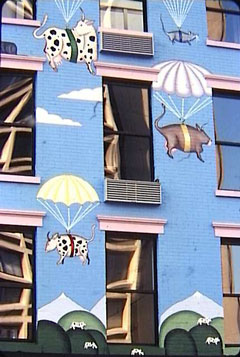 Manhattan, New York,
Manhattan, New York, in the mid-80s was far less streamlined than today's highly polished tourist showpiece. Above, town and country meet each other on a building façade in West Village. Lower East Side was still an area the police tried to steer well clear of after dusk, and Soho had just started to be colonized by people too hip for the Village. Union Square was dangerous, with muggers, down-and-outs and ordinary drunks filling the park. At the same time, the local residents did their best to protect their homes and property. The southern parts of Manhattan were a paradise, not only for the traditional artists but for graffiti artists too.
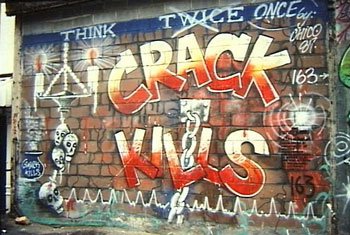 Crack was taking over
Crack was taking over district after district in New York in the 80s. But it was people you rarely see in the TV series (where the police and the criminals are forces to be reckoned with) who managed to turn the tide. It was the New Yorkers themselves who stopped their city turning into a slum. The graffiti painters did their bit.
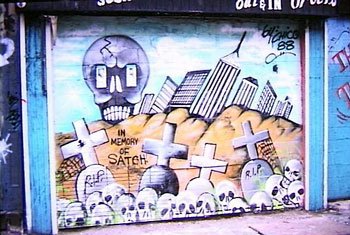 Yet another scene
Yet another scene from the Lower East Side in New York. The residents living around Tompkins Square Park took up the same fight as the people from Union Square. No more drugs, pushers, violence, or the fear of being robbed. Dog-owners began standing up for themselves, neighbours forced the police to do their job, paths and alleys were cleaned up and bulbs were replaced in street lights. The whole place started to become civilizeded again.
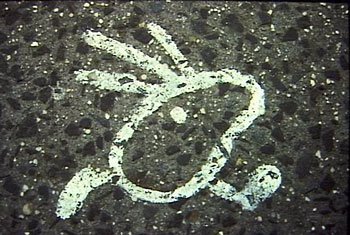 The Potato Man
The Potato Man made his appearance on the streets of New York in the early eighties. A rotund figure, hair blowing in the wind, in a hurry to get somewhere important. A citizen like any other. The city as canvass attracted painters and graffiti artists. Some made the transition from one category to the other: Keith Haring is the best-known example. It has been known for New York's subway police to arrest "art-lovers" caught demolishing subway walls where Haring had painted his little men. The potato man, always painted on the sidewalk, has not been the victim of such attacks. New York came up with the name "graffiti" and they have become as identified with the city as a Broadway musical. Films like "The Warriors" immortalised the image of the young man with a spray-can.
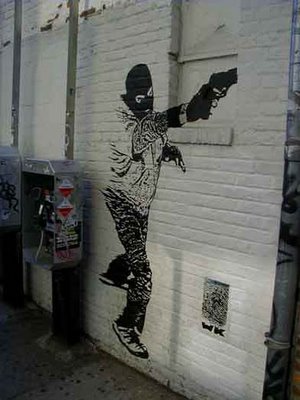 On Manhattan there's graffiti
On Manhattan there's graffiti and there's graffiti. One of the sharpest was the guy who did impressionist muggers in the 80s. Fast, rough brushstrokes, but always with movement, always catching the corner of your eye when you turned a corner at some badly lit crossroads in SoHo or the East Village - and were terrified. The artist behind the gunman above is perhaps more influenced by Frank Miller, but his predecessor in the 80s was much sharper.
 Manhattan, New York, in the mid-80s was far less streamlined than today's highly polished tourist showpiece. Above, town and country meet each other on a building façade in West Village. Lower East Side was still an area the police tried to steer well clear of after dusk, and Soho had just started to be colonized by people too hip for the Village. Union Square was dangerous, with muggers, down-and-outs and ordinary drunks filling the park. At the same time, the local residents did their best to protect their homes and property. The southern parts of Manhattan were a paradise, not only for the traditional artists but for graffiti artists too.
Manhattan, New York, in the mid-80s was far less streamlined than today's highly polished tourist showpiece. Above, town and country meet each other on a building façade in West Village. Lower East Side was still an area the police tried to steer well clear of after dusk, and Soho had just started to be colonized by people too hip for the Village. Union Square was dangerous, with muggers, down-and-outs and ordinary drunks filling the park. At the same time, the local residents did their best to protect their homes and property. The southern parts of Manhattan were a paradise, not only for the traditional artists but for graffiti artists too. Crack was taking over district after district in New York in the 80s. But it was people you rarely see in the TV series (where the police and the criminals are forces to be reckoned with) who managed to turn the tide. It was the New Yorkers themselves who stopped their city turning into a slum. The graffiti painters did their bit.
Crack was taking over district after district in New York in the 80s. But it was people you rarely see in the TV series (where the police and the criminals are forces to be reckoned with) who managed to turn the tide. It was the New Yorkers themselves who stopped their city turning into a slum. The graffiti painters did their bit. Yet another scene from the Lower East Side in New York. The residents living around Tompkins Square Park took up the same fight as the people from Union Square. No more drugs, pushers, violence, or the fear of being robbed. Dog-owners began standing up for themselves, neighbours forced the police to do their job, paths and alleys were cleaned up and bulbs were replaced in street lights. The whole place started to become civilizeded again.
Yet another scene from the Lower East Side in New York. The residents living around Tompkins Square Park took up the same fight as the people from Union Square. No more drugs, pushers, violence, or the fear of being robbed. Dog-owners began standing up for themselves, neighbours forced the police to do their job, paths and alleys were cleaned up and bulbs were replaced in street lights. The whole place started to become civilizeded again. The Potato Man made his appearance on the streets of New York in the early eighties. A rotund figure, hair blowing in the wind, in a hurry to get somewhere important. A citizen like any other. The city as canvass attracted painters and graffiti artists. Some made the transition from one category to the other: Keith Haring is the best-known example. It has been known for New York's subway police to arrest "art-lovers" caught demolishing subway walls where Haring had painted his little men. The potato man, always painted on the sidewalk, has not been the victim of such attacks. New York came up with the name "graffiti" and they have become as identified with the city as a Broadway musical. Films like "The Warriors" immortalised the image of the young man with a spray-can.
The Potato Man made his appearance on the streets of New York in the early eighties. A rotund figure, hair blowing in the wind, in a hurry to get somewhere important. A citizen like any other. The city as canvass attracted painters and graffiti artists. Some made the transition from one category to the other: Keith Haring is the best-known example. It has been known for New York's subway police to arrest "art-lovers" caught demolishing subway walls where Haring had painted his little men. The potato man, always painted on the sidewalk, has not been the victim of such attacks. New York came up with the name "graffiti" and they have become as identified with the city as a Broadway musical. Films like "The Warriors" immortalised the image of the young man with a spray-can. On Manhattan there's graffiti and there's graffiti. One of the sharpest was the guy who did impressionist muggers in the 80s. Fast, rough brushstrokes, but always with movement, always catching the corner of your eye when you turned a corner at some badly lit crossroads in SoHo or the East Village - and were terrified. The artist behind the gunman above is perhaps more influenced by Frank Miller, but his predecessor in the 80s was much sharper.
On Manhattan there's graffiti and there's graffiti. One of the sharpest was the guy who did impressionist muggers in the 80s. Fast, rough brushstrokes, but always with movement, always catching the corner of your eye when you turned a corner at some badly lit crossroads in SoHo or the East Village - and were terrified. The artist behind the gunman above is perhaps more influenced by Frank Miller, but his predecessor in the 80s was much sharper.

0 Comments:
Post a Comment
<< Home